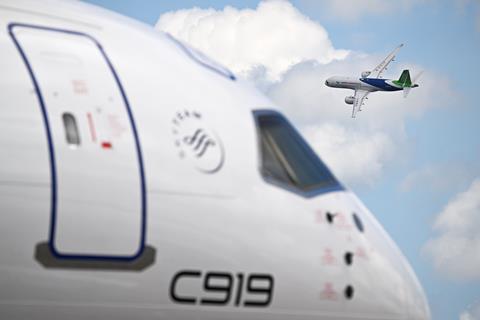While it might not have been the stand-out star of the Singapore air show for all visitors, the world-first appearance at such an event by Comac’s C919 was certainly highly significant.
With one example taking part in the flying display and another in the static park – also flanked by a pair of China-developed ARJ21 regional jets – Beijing’s narrowbody offering was definitely a high-profile presence.
Of course, Comac’s alternative to the Airbus A320neo and Boeing 737 Max is heavily reliant on western technologies, including its CFM International Leap-1C engines, making it a domestic product only up to a certain point.

However, its debut on the international show scene highlights that China’s aerospace industry can now build a product that is capable of meeting contemporary standards. That marks a significant and rapid advance when the single-aisle offering is viewed next to the more outdated-looking ARJ21.
So, should the commercial aircraft industry’s ‘big two’ be getting worried about the long-term prospects for guarding their current duopoly status? And how soon will the C919 begin to take even small bites out of their market?
Airbus commercial aircraft chief executive Christian Scherer deliberately sought not to dismiss the new model, although he does liken it to existing narrowbody offerings “without bringing any product differentiation”.
His approach is in marked contrast to that of the company’s previous commercial sales supremo John Leahy, who famously once tagged Bombardier’s CSeries as a ‘nice little airplane’ – only for Airbus to subsequently acquire the programme. It now produces the type as the A220.
“The cake is growing sufficiently for Comac to want to compete,” Scherer says of the Asia-Pacific market. However, his was no “let them eat cake” concession: Airbus “must not stick its head in the sand” through complacency, he stresses.
Underscoring this reality, Comac during the show announced a new deal to equip Tibet Airlines – which is currently an all-Airbus operator – with 40 C919s and 10 ARJ21s.
While Airbus maintained a respectful posture towards its new rival, Boeing’s current market offerings were conspicuous by their absence from the show’s static area. Instead, the US airframer was in crisis mode, staying away while its leaders again shifted their focus towards addressing recent quality shortfalls, especially on the 737 Max.
Sticking with the culinary metaphors, Boeing needs to get both its kitchen and recipes back in order – and quickly.
With the US company’s products absent, Beijing appeared eager to plug the gap, in what was a show of geopolitical intrigue.
At a time when Southeast Asian nations including Singapore are bolstering their air force capabilities in the face of China’s expansionist posture, some will have been surprised by the CAIC Z-10ME attack helicopter also making a debut international appearance in the city-state.
Beijing, it seems, has a very healthy appetite when it comes to the future of aerospace.
























